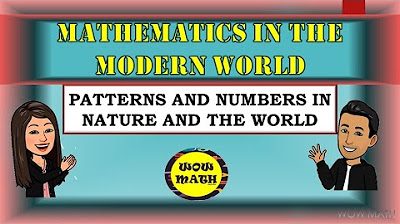Fibonacci Sequence in Nature
Summary
TLDRThe video script explores the Fibonacci sequence, a mathematical pattern found in nature, from the spirals of sunflowers and pineapples to the structure of galaxies. It suggests that this sequence, seen in the arrangement of florets, pinecone scales, and the growth of the nautilus shell, is a universal blueprint of design, hinting at a grand designer behind the cosmos.
Takeaways
- 🔢 The Fibonacci sequence starts with numbers 1, 1, followed by each subsequent number being the sum of the previous two, continuing indefinitely.
- 📏 A golden rectangle, when divided into smaller squares based on the Fibonacci sequence, creates a pattern that forms a Fibonacci spiral.
- 🌀 The Fibonacci spiral is significant due to its prevalence in natural phenomena, not just for its mathematical properties.
- 🌻 The florets of a sunflower are arranged in spirals that follow the Fibonacci sequence, with counts like 55, 34, and 21.
- 🍍 The fruit of the pineapple and the scales of a pinecone also exhibit spiral patterns based on the Fibonacci numbers.
- 🌊 Ocean currents and tidal waves form spirals that can be mathematically represented using the Fibonacci sequence.
- 🌳 The arrangement of buds on trees, the shape of sand dollars, and the pattern of starfish all follow the Fibonacci blueprint.
- 🐚 The Nautilus shell grows by adding segments that align with the Fibonacci sequence, showcasing this pattern in its structure.
- 🌌 The spiral structure of galaxies, averaging 100,000 light years across, also adheres to the Fibonacci sequence.
- 🌟 The ubiquity of the Fibonacci sequence in various scales of nature suggests a universal design principle or 'blueprint'.
- 🎨 The script implies that the consistent appearance of the Fibonacci sequence in diverse natural forms may indicate a grand design or 'trademark of a designer'.
Q & A
What is the Fibonacci sequence mentioned in the script?
-The Fibonacci sequence is a series of numbers where each number is the sum of the two preceding ones, starting from 0 and 1. It typically begins with 0, 1, 1, 2, 3, 5, 8, 13, 21, 34, and so on.
How is the Fibonacci sequence related to the golden rectangle?
-A golden rectangle has proportions that reflect the golden ratio, approximately 1.618. When divided into smaller squares based on the Fibonacci sequence, the resulting rectangles also exhibit these proportions, which is why breaking down a golden rectangle into Fibonacci squares creates a pattern that resembles the Fibonacci spiral.
What is the significance of the Fibonacci spiral?
-The Fibonacci spiral is a graphical representation of the Fibonacci sequence, where each quarter-turn of the spiral is proportional to the next. It is significant because it appears in nature, such as in the arrangement of leaves on a stem or the pattern of seeds in a sunflower.
Can you provide examples of natural phenomena that follow the Fibonacci sequence?
-Examples include the spirals of florets in a sunflower (55, 34, and 21), the pattern of fruit lips on a pineapple, the spirals on a pinecone, and the growth pattern of the Nautilus shell.
How does the script relate the Fibonacci sequence to the structure of galaxies?
-The script suggests that the spiral structure of galaxies, which can be diagrammed mathematically, follows the same design principles as the Fibonacci sequence, indicating a universal blueprint in the cosmos.
What is the golden ratio, and how is it connected to the Fibonacci sequence?
-The golden ratio is a mathematical constant, approximately equal to 1.618, often represented by the Greek letter phi (φ). It is connected to the Fibonacci sequence because as the sequence progresses, the ratio of two successive Fibonacci numbers approximates the golden ratio.
How does the arrangement of petals on flowers relate to the Fibonacci sequence?
-Many flowers have a number of petals that are Fibonacci numbers, such as 3, 5, 8, 13, etc. This arrangement allows for the most efficient use of space and resources, which is why it is prevalent in nature.
What is the significance of the Nautilus shell in the context of the Fibonacci sequence?
-The Nautilus shell grows by adding new chambers in a spiral pattern that follows the Fibonacci sequence. Each new chamber is approximately the next number in the sequence, creating a logarithmic spiral that fits the golden ratio.
Can the Fibonacci sequence be observed in the growth patterns of trees?
-Yes, the Fibonacci sequence can be observed in the branching patterns of trees, where each branch divides into two smaller branches, following the sequence's growth pattern.
What does the script imply about the universality of the Fibonacci sequence?
-The script implies that the Fibonacci sequence is a fundamental pattern found throughout nature, from the smallest organisms to the vast structure of galaxies, suggesting a universal blueprint or design principle.
What is the philosophical or metaphysical implication of the script's discussion on the Fibonacci sequence?
-The script suggests a metaphysical or philosophical implication that the prevalence of the Fibonacci sequence in nature and the cosmos might be evidence of an underlying design or 'trademark of a designer'.
Outlines

此内容仅限付费用户访问。 请升级后访问。
立即升级Mindmap

此内容仅限付费用户访问。 请升级后访问。
立即升级Keywords

此内容仅限付费用户访问。 请升级后访问。
立即升级Highlights

此内容仅限付费用户访问。 请升级后访问。
立即升级Transcripts

此内容仅限付费用户访问。 请升级后访问。
立即升级浏览更多相关视频

The Mind-Blowing Mathematics of Sunflowers - Instant Egghead #59

Evidence for God: The Fibonacci Sequence

GEC104 Video Lecture 1 - Mathematics in our World (Part 2): Fibonacci Sequence and Golden Ratio

APAKAH TUHAN AHLI MATEMATIKA??

PART 3: PATTERNS AND NUMBERS IN NATURE AND THE WORLD || MATHEMATICS IN THE MODERN WORLD

Gods Fingerprint, The Fibonacci Sequence , Golden Ratio and The Fractal Nature of Reality
5.0 / 5 (0 votes)
